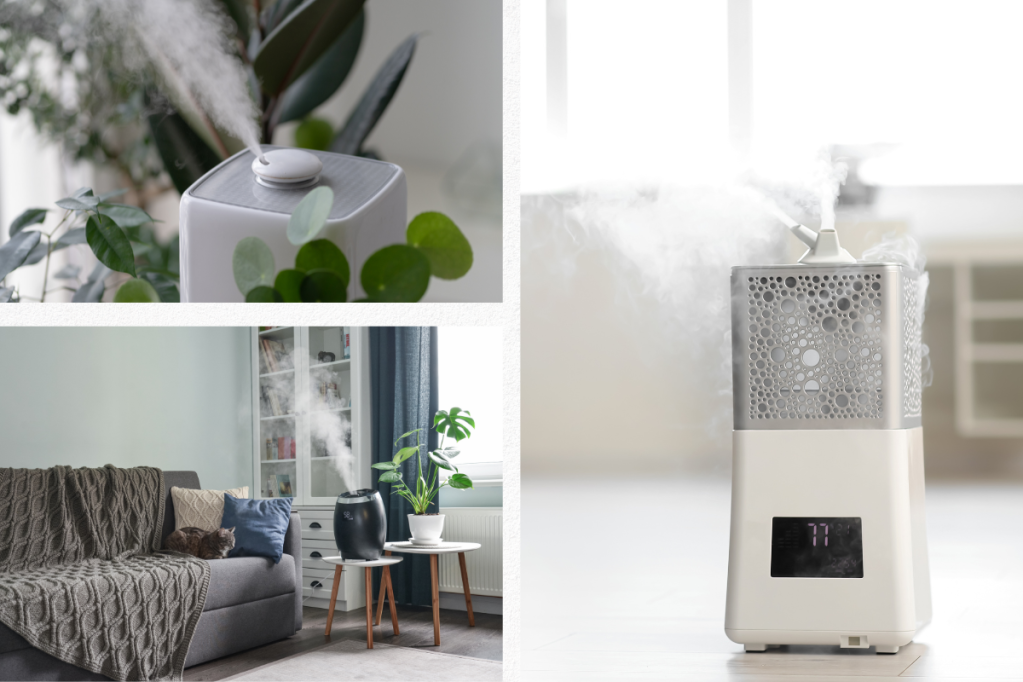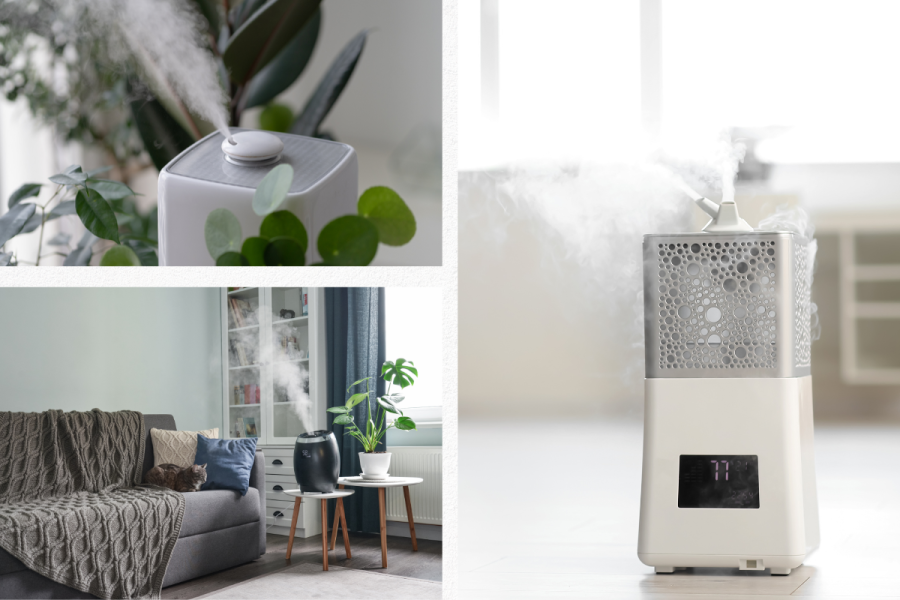Discover the ultimate showdown between humidifiers vs. purifiers, two devices designed to improve air quality. Uncover the pros and cons and choose wisely!

Understanding the Differences Between Humidifier vs. Purifier
It’s crucial to understand the differences between a humidifier and a purifier before buying one. A humidifier adds moisture to the air, while an air purifier removes dust, pollen, and pet dander. Despite their variations, both devices are vital for indoor air quality.
Dry skin, nosebleeds, and sinusitis are alleviated by humidifiers. In low-humidity settings, airborne viruses and bacteria thrive. Yet, a purifier filters out contaminants that might cause respiratory issues, allergies, and asthma. It also removes harmful odors and mold spores from the air.
Consider your home’s humidity and air quality before buying a humidifier or purifier. A humidifier can prevent respiratory difficulties in dry climates by adding moisture to the air. If you reside in a very polluted location, an air purifier is necessary to remove contaminants. If you’re not sure which equipment to buy, consider a combo humidifier and purifier.
Humidifier vs. Purifier: Balancing Moisture Levels for Improved Health
For years, humidifier vs. purifier debates have raged. Nevertheless, air purification and humidity levels must be balanced for wellness. Mold and germs can thrive in high humidity. Dry throat, nose, and skin can also result from low humidity.
Indoor air quality is improved by air purifiers that capture allergies, dust, and germs. This is vital for asthmatics and allergy sufferers. Smoke, pet, and culinary odors can be removed with a purifier. Adding moisture to the air using a humidifier helps relieve sinusitis, asthma, and nosebleeds.
Invest in a humidifier and purifier to balance the environment. This ensures your home has optimal humidity and air quality. Monitor humidity and get an air purifier if you reside in a polluted location. Finally, clean and replace both devices’ filters as indicated by the makers.
Humidifier vs. Purifier: Which is Right for Your Home?
Several considerations should be addressed while deciding between a humidifier and a purifier for your house. Consider the air quality and humidity in your home first. If the air is dry, use a humidifier, but if it’s contaminated, use a purifier. Second, examine your individual needs, such as relieving allergies or respiratory disorders, which both devices can do. Your preferences and circumstances will determine the best option.
Low-humidity residents benefit from humidifiers. It relieves dry skin, nosebleeds, and respiratory issues by providing moisture to the air. Humidifiers can also stop viruses and germs from spreading in dry air. Nevertheless, purifiers use filters to collect pollutants like dust, pollen, and pet dander, improving air quality.
When choosing between a humidifier and a purifier, consider a combined device. This device keeps your home’s air moist and clean by acting as a humidifier and purifier. If you have allergies or respiratory issues, visit a doctor to establish which device is appropriate for you.
Your specific needs should determine whether to buy a humidifier or purifier. Yet, a combination device may be the most cost-effective and practical option, offering the benefits of both technologies in one appliance.
Humidifier vs. Purifier: Cost and Maintenance Considerations
Humidifiers and purifiers cost and require maintenance based on numerous criteria. First, depending on type, brand, and features, the initial cost of each gadget might vary greatly. Second, consider the continuing expenditures of replacing filters and cleaning.
Several £20 humidifiers are available. Advanced models might cost more than £200. Humidifiers need regular cleaning and filter replacement to avoid bacteria and mold growth, which raises maintenance costs. Purifiers are more expensive than humidifiers, with some units costing over £500. Reusable filters can save maintenance expenses in several models.
Both gadgets must be maintained properly. To prevent bacteria growth, a humidifier’s water tank should be cleaned routinely and its filter replaced every 3-6 months. According to the manufacturer, purifier filters should be changed every 6–12 months. Device functionality and health risks can decrease if maintenance is neglected.
Humidifiers and purifiers must be considered in terms of original cost, continuing maintenance, and care. Humidifiers are cheap but require maintenance, while purifiers are more expensive but feature reusable filters. Investing in a high-quality device and proper maintenance ensures optimal operation and improves indoor air quality.
Humidifier vs. Purifier: Pros and Cons
Humidifiers and purifiers improve air quality in homes and offices. Nonetheless, they offer different benefits and cons. To help you choose a humidifier or purifier for your home or office, we’ll compare their advantages and cons in this post.
Humidifiers increase atmospheric humidity. They help persons with dry skin, nosebleeds, and other respiratory issues caused by dry air. Humidifiers can be evaporative, ultrasonic, or steam. Your demands and preferences determine which type to choose.
A humidifier can help with respiratory issues. Asthma, allergies, and sinusitis can worsen in dry air. Humidifiers can alleviate these symptoms and improve your health by adding moisture to the air. Dry air can cause wrinkles, dryness, and other skin issues, but humidifiers can help.
A humidifier has various drawbacks. If your home’s humidity is too high, mold and bacteria can thrive, aggravating allergies and other respiratory issues. Bacteria can grow in your humidifier if you don’t clean it regularly.
Nevertheless, air purifiers eliminate contaminants and allergens. They help allergy and asthma sufferers. Purifiers include HEPA filters, activated carbon filters, and UV-C light purifiers. Your demands and preferences determine which type to choose.
Purifiers remove pollutants and allergens from the air, enhancing its quality. Allergies, asthma, and other respiratory disorders may improve. Purifiers also remove undesirable odors from the air, making your house or office more comfortable.
Nevertheless, purifiers have downsides. Purifiers can be noisy, especially high-powered ones. Some purifiers emit ozone, which is dangerous in high doses. Purifiers should also be cleaned regularly to prevent bacteria from growing.
Conclusion
Maintaining indoor air quality requires a humidifier and purifier. A humidifier adds moisture to the air, while a purifier eliminates dangerous contaminants. To improve health, humidity and air purification must be balanced. So, purchasing both devices or monitoring humidity levels can help attain this equilibrium.
Choosing to buy a humidifier or purifier depends on your home’s demands, air quality, and humidity. Combination devices may be the most cost-effective, combining the benefits of both technologies. While examining the cost and maintenance of each equipment, it’s important to consider the initial cost, continuing maintenance expenditures, and correct care. Investing in a good device and maintaining it is essential for optimal operation and better indoor air quality. Both devices need regular cleaning and filter replacement to prevent bacteria and mold growth, which can cause health problems. Neglecting maintenance can also degrade device performance, which defeats the purpose of investing in these gadgets.
Home and office air quality can be improved with humidifiers and purifiers. They serve distinct objectives and have different pros and cons. If dry air exacerbates your respiratory issues, a humidifier may help. If you have allergies or other respiratory issues caused by air contaminants, a purifier may be best for you. To get the most out of your equipment and avoid health hazards, use it properly and clean it often.
